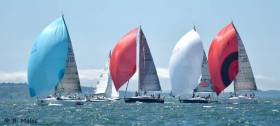Displaying items by tag: Women's Open Keelboat Championship
The Women's Open Keelboat Championship (WOKC) will be returning to Hamble for its 11th edition in June 2019.
This year the event hosted once again by Hamble River Sailing Club, is being held on the weekend of 1st & 2nd June 2019. The volunteer team which organises WOKC is delighted that Dubarry has agreed to return as title sponsor, having been a generous supporter of the championships since their inception in 2008 and having been the title sponsor for the last 7 events. Participants in the Dubarry Women’s Open Keelboat Championships will have the opportunity to win much admired Dubarry items, which will be available as prizes for class winners and in the overall Championship.
Long-standing supporter and competitor Laura Dillon from Howth Yacht Club commented, “I am delighted to be participating in another WOKC. Every year, this is a great event and I am really looking forward to the Magenta Project coaching on Friday, 31st May and WOKC on 1 and 2 June. WOKC continues to go from strength to strength both in terms of the number of boats, size of boats, number of ladies racing and the standard of the competition continues to increase, which is fantastic! I have participated for over 5 years now and I look forward to the regatta annually. Thanks so much to Dubarry for their continued support and hopefully we can continue to grow WOKC and encourage as many female sailors as possible to participate in 2019 and beyond!”
Entries open on Thursday 28th of March and early entry is advised to take advantage of the Earlybird booking fee of £75, available until 17:00 on Friday 17th May. After that date, the entry fee will increase to £95. Boat entry is available from HRSC either online or via the admin team on 02380 452070.
Women's Open Keelboat Championship Returns In 2015
#Racing - The UK Women's Open Keelboat Championship returns in 2015 after a year off, as The Daily Sail reports.
The event is again title-sponsored by Irish boat shoe specialists Dubarry – and that Irish connection continues in the form of 2013's champions, led by Howth Yacht Club's Laura Dillon.
It's not yet known if the same team will return to defend their title, but entries will open early next month for this September's championship at the Hamble River Sailing Club in Southampton, with racing scheduled for the earlier weekend of 30-31 May.
The Daily Sail has more on the story HERE.

























































